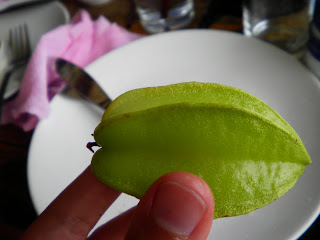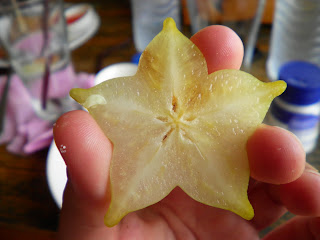A Greek goddess statue:

The pavilion where the king could paddle his boat and rest alone, enjoying the cool summer breezes:

Hedges shaped like elephants (I think that’s a modern addition):

A watchtower (where people can now get a view of the entire palace grounds:

Golden shower, the national flower of Thailand:

A Chinese temple dedicated by Chinese merchants:

A Buddhist temple shaped like a church:

For lunch, we stopped at a local restaurant and I got to try star fruit Here is the whole fruit:

Here’s what it looks like when cut:

You can see how it gets its name. My friend James once told me that they grow star fruit where he lives, in Hawaii. But you can’t find it in an Oklahoma supermarket!
Next, we drove a long way to the ancient ruins of Ayutthaya. Edited from the brochure:
From the 16th to 18th century, Ayutthaya was the capital and cultural center of the central Thai kingdom. It was a delicate blend of Dvaravati, Khmer, Mon and Lawa cultures. The reigns of 33 kings gave Ayutthaya a great number of fine buildings, monuments and works of art. In 1767, the city was completely destroyed by the Burmese. The remains of the island city are now of extreme archaeological importance and the extensively restored historical park of Ayutthaya was selected as a UNESCO world heritage site in 1994. There is ample time to admire the countless ruins of palaces, temples and monuments scattered over the park.
Here’s my favorite picture I took of Ayutthaya:

Reminds me of a video game I used to play as a child, Breath of Fire III. I wonder if the designers modeled some of those ruins off the ruins in Ayutthaya.
From there we went on to Sukhothai and spent the night in a museum-style hotel there. Here’s me in front of a strange palm tree:

The next morning we rode rented bicycles around the one-square-mile Sukhothai Historical park. Edited from the brochure:
Shkhothai was the first capital of Thailand (then Siam-- the land of smiles) which enjoyed a golden age under King Ramkhamhaeng, credited with creating the Thai alphabet (we saw his statue). The superb palaces, temples and monuments of this great city have been lovingly restored in Sukhothai Historical Park, a UNESCO World Heritage Site and a must-see for all travelers. The Ramkhamhaeng National Museum in Sukhothai city contains an outstanding collection of statues, Buddha images and old celadon found within the old city. Many of Sukhothai's important sites are included inside the old city walls.
Most interesting about the museum were the many Buddhist, Hindu, and folk stories written on ancient tablets and translated into English. We learned how in a small village in Thailand, once a year they still see "Naga fire" from the ancient mythological snakes in the lake. No one, not even scientists, know what causes the phenomenon.
Here’s some of my favorite pictures of Sukhothai:



Hindu, traditional Thai, Cambodian, Burmese, Indian, Hindu, Chinese, and Buddhist architecture all blended together. It was really something to see!
The following day, we went up North to Lampang and Chiang Mai. More on that later!

No comments:
Post a Comment